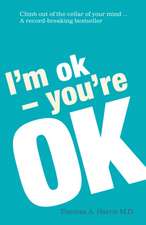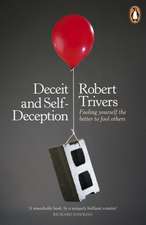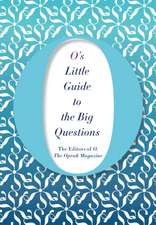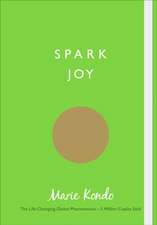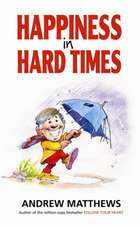Color Smart: How to Use Color to Enhance Your Business and Personal Life
Autor Mimi Cooper, Arlene Modica Matthewsen Limba Engleză Paperback – 30 iun 2000
Over the years, Mimi Cooper has given her innovative insights to many Fortune 500 companies. So who is Ms. Coopers latest high-profile, fast-forward client?
YOU
Filled with insider secrets that are both fun and fascinating, this is the book that reveals what only the top experts know about color. ColorSmart explains how color impacts all of us and shows you how to use that information. Discover:
- How to identify and make the most of your own color profile -- are you Color Forward®, Color Prudent®, or Color Loyal®?
- Our unconscious reactions to color
- What colors to use for business presentations to create enthusiasm for your ideas
- How to use color to sell a house at the best price
- Where the most "in" colors of the moment really come from
Preț: 91.42 lei
Nou
Puncte Express: 137
Preț estimativ în valută:
17.50€ • 18.100$ • 14.70£
17.50€ • 18.100$ • 14.70£
Carte disponibilă
Livrare economică 01-15 aprilie
Preluare comenzi: 021 569.72.76
Specificații
ISBN-13: 9780671034597
ISBN-10: 0671034596
Pagini: 176
Ilustrații: + 8 pg 4-c insert
Dimensiuni: 140 x 214 x 13 mm
Greutate: 0.24 kg
Ediția:Original
Editura: Gallery Books
Colecția Gallery Books
ISBN-10: 0671034596
Pagini: 176
Ilustrații: + 8 pg 4-c insert
Dimensiuni: 140 x 214 x 13 mm
Greutate: 0.24 kg
Ediția:Original
Editura: Gallery Books
Colecția Gallery Books
Notă biografică
Mimi Cooper is a principal of the Cooper Marketing Group Inc. A former executive vice president of a leading regional home furnishings retailer, she has more than twenty years of experience consulting on color for a vast range of products -- from automobiles and paints to kitchen accessories and lingerie. A frequent speaker at design seminars and retail conferences throughout North America and Europe, Cooper lives with her husband in Oak Park, Illinois.
Cuprins
Contents
The Importance of Color
An Introduction
1. Becoming Color Smart
Understanding Color Profiles
2. Advanced Color Smarts
Understanding Color Signals
3. Color in the Marketplace
How the Pros Use Color
4. Applied Color Smarts
Using Color in Your Life
5. Kids' Colors
6. Place Palettes
The Colors of Foreign Countries
7. The Future of Color
Epilogue
Color Ad Infinitum
Extras
Chapter One: Becoming Color Smart
Understanding Color Profiles
I've been a marketing consultant for over twenty years. When I started helping my clients to use color in their products I knew very little, but I made a lot of assumptions:
Well, I wasn't wrong about everything. Blue is the most popular. But otherwise, I had a lot to learn.
In the real world, the yuppies are too busy and the rich too conservative to experiment with the newest colors. And new colors don't just come from a few high-profile designers. Besides, if the rest of us don't like the new colors, they fail.
So who really tries new colors first? And what are other people doing about color?
After a great deal of research, we saw unquestionably that there are three distinct color personalities. We named and trademarked these three color personality profiles as Color-Forward®, Color-Prudent®, and Color-Loyal®.
Understanding these three personalities -- in terms of what they signify and who tends to fit into their profiles -- wilI be your first step toward becoming Color Smart. However, if you're like most people, the first thing you want to know is: Which one do I fit into?
So before we tell you what traits members of each of these three groups tend to exhibit (and therefore perhaps influence your evaluation of which one you think you'd like to be), we offer this simple self test to see with what type you will "cluster."
First simply check off all the following statements with which you agree. And if you strongly agree with a statement, give it two checks. For now, just ignore the letters in parentheses that follow them. There are no "right" or "wrong" answers. It's all a matter of opinion. As you are answering, think about your recent color choices -- a dress, a shirt, a tie, an automobile, place mats, upholstery, or carpeting.
Now just count up your total number of check marks (doubles for "strongly agree" count as two), and see whether you have more A's, B's or C's.
If you scored more A's, you are what we call Color-Forward; more B's and you are ColorPrudent; more C's, Color-Loyal. You'll undoubtedly recognize yourself in the section below that defines your group's predominant characteristics.
We understand if you want to sneak a peek ahead in the text to locate yourself and your kindred color spirits -- but do be sure to read all three profiles. After we describe them, we will explain how you can use them to your greatest advantage in your personal and professional life.
BEING COLOR-FORWARD
Every year, these people can't wait to see the new colors for fall; they can't wait to see the new colors for spring. They want to do more than view these colors out of curiosity. They long to embrace them and make them their own.
Color-Forward women love to peruse store displays for the latest color trends. You'll usually find them wearing the latest "in" shades. And they don't necessarily care if the new colors don't go with everything else they have. They're willing to spend more on a wardrobe to keep it "color current."
Color-Forward men are intrigued by new colors for cars, trucks, and SUVs, and you'll often find them driving a vehicle in a color none of their pals has yet tried. (This is the sort of guy who was big, for example, on the Ford Mustang iridescent "mood-ring" color that looked purplish from one angle and bluish/teal from another.
No self-respecting Color-Forwards would ever consider redecorating their home in colors they'd previously tried. And when they buy a new house, the first thing they do is repaint and recarpet in new colors. Their home furnishings tend to be contemporary, and they enjoy using their homes, like their clothing and their automobiles, to make bold and exciting statements. They often try more than one new color at a time, experimenting with daring combinations. They are the people that would cheerfully have paid $200 more for the colored iMac computer when it made its debut.
From a psychological perspective, Color-Forwards tend to evince personality traits of self-confidence, adventurousness, and enthusiasm. They are less afraid than the average bear when it comes to going out on a limb and taking risks. And as you may have suspected, they are not put off by change, but tend to welcome it.
From an economic perspective, it is Color-Forwards who drive consumer markets. They spend a lot on themselves, and feel they're worth it.
Demographically (for demographics are still part of the equation), Color-Forwards make up about 20 percent of the population. More women than men are Color-Forward, and Hispanics and African Americans are more likely to be Color-Forward.
Interestingly, this category tends to contain two disparate age groups. First, there are the teens through thirtysomethings, who pride themselves on having an up-to-the-minute sense of style. One might well expect them to be Color-Forward. However, they are often joined by another set -- women and men in the forty-five to sixty-five age bracket whose kids have grown, who have more disposable income, and who use splashes of new color to feel youthful and invigorated. For them, the goal of being "cool" or trendy is what we call a revisited value.
If you live in a city in the Southwest or the MidAtlantic States, you are statistically more liable to be Color-Forward. But Color-Forwards can, and do, pop up everywhere.
BEING COLOR-PRUDENT
Don't be surprised if you feel most comfortable in this category, for it is where half of us fall. Color-Prudents are somewhat cautious when it comes to color choice. They want to feel secure in the knowledge that new colors will be around for more than one fleeting season, that big-ticket items in new shades will retain their resale value, and that they won't quickly grow tired of what they buy.
True, they're not trying to be on the cutting edge of color fashion, but they do believe color adds zip to life and they are interested in what's up and coming. They pay attention to store displays and catalogs to see what colors have staying power.
On a given day, you might find them dressed in the same color as a Color-Forward friend, but odds are high that they would have added that color to their wardrobe months later, after others had tested the waters. And often, when they try a new color, they try it in a small dose at first, perhaps as an accessory, and in combination with a trusty old color they are used to.
Color-Prudents are not resistant to change, but they do not make change for its own sake. They are informed and pragmatic and want to know that whatever changes they make will prove functional and useful for some time to come. They are also attentive and will distinguish and seek out, for example, softer shades within a color.
Being impulsive is not among the personality traits of the Color-Prudent type. But neither are these people sticks in the mud. Though involved in lots of other things, they enjoy the idea of updating a wardrobe or home now and again.
Demographically, men and women comprise equal halves of Color-Prudents. And this group falls mostly in the middle-income range.
BEING COLOR-LOYAL
The only way a Color-Loyal sort of person is likely to try a new color is -- not to put too fine a point on it -- kicking and screaming. For this group, traditional values are the be-all and end-all.
Usually Color-Loyals are comfortable with consistency in colors and don't plan on changing. These people have found what they like and what works for them, and they stick with it. If their navy windbreakers have seen better days, they'll replace them with new navy windbreakers (and if they can't find the same shade, they'll whine about it.) They are stalwarts who like what they like, and believe new stuff never looks as good on them as their old stuff. Even if they have a fashion flair, they don't give a fig for the trends of the moment.
Think of men in navy blazers, charcoal gray pants, light blue or white shirts, and ties with perhaps a bit of red in small, tasteful patterns. Think of women in black (they wouldn't have worn this color ten years ago, when it was considered cutting edge, but they will now since black has evolved into mainstream " safe"). Now picture them all sitting on dark brown couches in homes that are furnished in either country/casual or traditional/formal. And imagine them driving black automobiles. These are your classic Color-Loyals.
Of course, this description may lead you to think that Color-Loyals tend to be older and "stuffier" than the average person. But, interestingly enough, that would be a false preconception. Among the most tried-and-true Color-Loyals are extremely busy, sometimes overtaxed people (e.g., young urban professionals or working mothers with young children) who simply have little time or patience for the "luxury" of sampling colors that don't coordinate with everything else they own.
Demographically, the income of older ColorLoyals is significantly lower than the other two groups. Men in this group outnumber women two to one, and they tend to be older.
OF RARE EXCEPTIONS AND SWEATSUITS IN CHARTREUSE
Color personalities are highly relevant to nearly every decision each of us makes about what to buy, what to wear, what to drive, and what to surround ourselves with.
Naturally there are times when all of us may step outside the confines of our preferred color personality (few of even the most Color-Forward among us wants a magenta sofa, and any of us might pick a beige carpet because it works well in a large area), but, by and large, we stay within the realm of our profile and choose from its color palette.
In fact, when someone makes a choice outside what is generally their customary norm, the rest of us notice.
We knew a middle-aged gentleman named Jim, for example, a down-to-earth, plain-living sort who generally dressed in unremarkable colors. But one day he showed up at a casual social event in the brightest of bright chartreuse sweatsuits. (Chartreuse was a color that had briefly been in vogue the previous season.) Everyone noticed, to say the least. We even heard a friend of ours comment that he looked like a "squished caterpillar."
The brightly clad gentleman, however, maintained that this was the most comfortable piece of clothing he'd ever come across -- and he couldn't understand why it had been on sale for only ten dollars.
Finally, one of his cronies could stand it no longer.
"Jim, are you color-blind?" he asked, flabbergasted.
"Why, yes," replied Jim. "As a matter of fact, I am."
KNOWLEDGE IS POWER
So what do these color personalities mean in terms of your becoming Color Smart?
The answer is they mean a great deal.
Manufacturers have known for quite some time that colors can be used to influence people's decisions and behaviors, likes and dislikes. Understanding how color influences people can give us an advantage in all our dealings.
You see, on one level, people gravitate toward one palette or another because a certain range of colors represents how they see themselves and where they feel most secure. But, on another level, they react to other people based in part on whether or not the palettes of those other people provide them with a level of comfort or not.
Now you might think, okay, that's simple enough. If I want someone to relate to me well I should choose colors from their palette of choice when I interact with them. Well, you'd be right -- but only part of the time.
Certainly, in many cases, we feel most at ease with and most open to people we perceive as being like us. So if you're about to meet your in-laws-to-be and want to "fit in," some good advice would be to ask your fiancé how they normally dress or how their home is decorated.
parSometimes people feel most comfortable with others who dress in palettes that may not match their own but that nevertheless meet their expectations.
Because color choice tends to signify certain characteristics, we can indicate that we possess those characteristics by how we employ color.
For example, let's say you are going into a situation where it would benefit you to impress people with the fact that you are bold and future-oriented (perhaps you hope to design brilliant new products for them, or create a hot new ad campaign). Even if it's a group of ultraconservative Color-Loyals you're addressing, you will probably get more respect from them if your choices of colors indicate that you are more adventurous than they are.
On the other hand, if you are, say, trying to sell annuities to a group of retirees -- yes, even the ones who sport outrageously colored golf clothes (a little Color-Forward diversion geared for the sporting set as a fun and energizing change of pace) -- you want to look conservative, thoughtful, and reliable. Your choice of colors should reflect those values, and you might want to leave any tangerine items hanging in your closet right where they are.
RULES TO COLOR BY
In general, color personality rules are easy to observe, and we have boiled them down to a simple trio. To use these rules, it is necessary to think of the three color profiles in a sort of stack, with Color-Forward at the top, and Color-Loyal at the bottom.
Color-Forward
Color-Prudent
Color-Loyal
Now apply the following principles:
That's all there is to it -- almost. You may be wondering if we're not forgetting something. That is, if you're stuck in one palette yourself, how can you make choices "outside your box"?
Well, here is the key. While nearly everyone else gravitates toward one color personality without being consciously aware of why they do it (or even that they are doing it), you now have the gift of awareness. With awareness, change is not only possible, it's almost inevitable.
A good thing, too, because if you are going to be Color Smart, you are going to want to expand your personal options to fit given circumstances.
Energy and enhanced effectiveness are a direct result of flexibility, and of looking at old things in new ways. So to use these personality profile rules, you will have to turn a fresh eye on your color choices and ask yourself if they couldn't do with a bit more variety.
MOVING TOWARD THE NEXT STEP
We definitely don't recommend you run right out and buy this, that, and the other thing in fifteen different colors. For now, just start noticing different people's palettes and visualize yourself trying to communicate something to them through color.
Even after you do these mental exercises, don't go on a buying or painting or redecorating spree. In order to be fully Color Smart, you must first understand something in addition to color personalities. You must learn about the powerful signals that individual colors send.
Copyright © 2000 by Mimi Cooper
Understanding Color Profiles
I've been a marketing consultant for over twenty years. When I started helping my clients to use color in their products I knew very little, but I made a lot of assumptions:
- Fashionable (new) colors are first tried by the rich and by young, urban professionals.
- From them the colors trickle down to the rest of us.
- New colors are determined by a few powerful designers somewhere -- maybe Paris -- and the rest of us are forced to follow along.
- Blue is the most popular color.
Well, I wasn't wrong about everything. Blue is the most popular. But otherwise, I had a lot to learn.
In the real world, the yuppies are too busy and the rich too conservative to experiment with the newest colors. And new colors don't just come from a few high-profile designers. Besides, if the rest of us don't like the new colors, they fail.
So who really tries new colors first? And what are other people doing about color?
After a great deal of research, we saw unquestionably that there are three distinct color personalities. We named and trademarked these three color personality profiles as Color-Forward®, Color-Prudent®, and Color-Loyal®.
Understanding these three personalities -- in terms of what they signify and who tends to fit into their profiles -- wilI be your first step toward becoming Color Smart. However, if you're like most people, the first thing you want to know is: Which one do I fit into?
So before we tell you what traits members of each of these three groups tend to exhibit (and therefore perhaps influence your evaluation of which one you think you'd like to be), we offer this simple self test to see with what type you will "cluster."
First simply check off all the following statements with which you agree. And if you strongly agree with a statement, give it two checks. For now, just ignore the letters in parentheses that follow them. There are no "right" or "wrong" answers. It's all a matter of opinion. As you are answering, think about your recent color choices -- a dress, a shirt, a tie, an automobile, place mats, upholstery, or carpeting.
- I will pay more for new, fashionable colors in clothing. (A)
- I usually buy new colors/products after my friends have tried them. (B)
- I buy products in colors that are practical, rather than stylish. (C).
- I have to see a color several times before I get used to it. (B)
- I feel good when I buy something in a new color for myself. (A)
- I rarely try a new color unless someone else suggests it. (C)
- I think the new colors in clothing do not look as good on me as the colors I usually wear. (C)
- I am a middle-of-the-road person in choosing colors -- some new and some old favorites. (B)
- I would rather buy something in a new, fashionable color than replace something with the same color. (A)
- I am excited to see the new colors of the season. (A)
- I do not have time to figure out how to add a new color to my wardrobe. (B)
- I like basic, traditional colors. (C)
- Shopping would be better if there were fewer changes in color from year to year. (C)
- I like to be considered a leader when it comes to buying new products on the market. (A)
- I am too practical to try a new color the first time I see it. (B)
- I am not the first person to try new colors, but I will try them when I have seen them a few times. (B)
- I like to learn about the newest fashionable colors from magazines, salespeople, store displays, etc. (A)
- I will buy fashionable colors only if I think they are not a fad. (C)
Now just count up your total number of check marks (doubles for "strongly agree" count as two), and see whether you have more A's, B's or C's.
If you scored more A's, you are what we call Color-Forward; more B's and you are ColorPrudent; more C's, Color-Loyal. You'll undoubtedly recognize yourself in the section below that defines your group's predominant characteristics.
We understand if you want to sneak a peek ahead in the text to locate yourself and your kindred color spirits -- but do be sure to read all three profiles. After we describe them, we will explain how you can use them to your greatest advantage in your personal and professional life.
BEING COLOR-FORWARD
Every year, these people can't wait to see the new colors for fall; they can't wait to see the new colors for spring. They want to do more than view these colors out of curiosity. They long to embrace them and make them their own.
Color-Forward women love to peruse store displays for the latest color trends. You'll usually find them wearing the latest "in" shades. And they don't necessarily care if the new colors don't go with everything else they have. They're willing to spend more on a wardrobe to keep it "color current."
Color-Forward men are intrigued by new colors for cars, trucks, and SUVs, and you'll often find them driving a vehicle in a color none of their pals has yet tried. (This is the sort of guy who was big, for example, on the Ford Mustang iridescent "mood-ring" color that looked purplish from one angle and bluish/teal from another.
No self-respecting Color-Forwards would ever consider redecorating their home in colors they'd previously tried. And when they buy a new house, the first thing they do is repaint and recarpet in new colors. Their home furnishings tend to be contemporary, and they enjoy using their homes, like their clothing and their automobiles, to make bold and exciting statements. They often try more than one new color at a time, experimenting with daring combinations. They are the people that would cheerfully have paid $200 more for the colored iMac computer when it made its debut.
From a psychological perspective, Color-Forwards tend to evince personality traits of self-confidence, adventurousness, and enthusiasm. They are less afraid than the average bear when it comes to going out on a limb and taking risks. And as you may have suspected, they are not put off by change, but tend to welcome it.
From an economic perspective, it is Color-Forwards who drive consumer markets. They spend a lot on themselves, and feel they're worth it.
Demographically (for demographics are still part of the equation), Color-Forwards make up about 20 percent of the population. More women than men are Color-Forward, and Hispanics and African Americans are more likely to be Color-Forward.
Interestingly, this category tends to contain two disparate age groups. First, there are the teens through thirtysomethings, who pride themselves on having an up-to-the-minute sense of style. One might well expect them to be Color-Forward. However, they are often joined by another set -- women and men in the forty-five to sixty-five age bracket whose kids have grown, who have more disposable income, and who use splashes of new color to feel youthful and invigorated. For them, the goal of being "cool" or trendy is what we call a revisited value.
If you live in a city in the Southwest or the MidAtlantic States, you are statistically more liable to be Color-Forward. But Color-Forwards can, and do, pop up everywhere.
BEING COLOR-PRUDENT
Don't be surprised if you feel most comfortable in this category, for it is where half of us fall. Color-Prudents are somewhat cautious when it comes to color choice. They want to feel secure in the knowledge that new colors will be around for more than one fleeting season, that big-ticket items in new shades will retain their resale value, and that they won't quickly grow tired of what they buy.
True, they're not trying to be on the cutting edge of color fashion, but they do believe color adds zip to life and they are interested in what's up and coming. They pay attention to store displays and catalogs to see what colors have staying power.
On a given day, you might find them dressed in the same color as a Color-Forward friend, but odds are high that they would have added that color to their wardrobe months later, after others had tested the waters. And often, when they try a new color, they try it in a small dose at first, perhaps as an accessory, and in combination with a trusty old color they are used to.
Color-Prudents are not resistant to change, but they do not make change for its own sake. They are informed and pragmatic and want to know that whatever changes they make will prove functional and useful for some time to come. They are also attentive and will distinguish and seek out, for example, softer shades within a color.
Being impulsive is not among the personality traits of the Color-Prudent type. But neither are these people sticks in the mud. Though involved in lots of other things, they enjoy the idea of updating a wardrobe or home now and again.
Demographically, men and women comprise equal halves of Color-Prudents. And this group falls mostly in the middle-income range.
BEING COLOR-LOYAL
The only way a Color-Loyal sort of person is likely to try a new color is -- not to put too fine a point on it -- kicking and screaming. For this group, traditional values are the be-all and end-all.
Usually Color-Loyals are comfortable with consistency in colors and don't plan on changing. These people have found what they like and what works for them, and they stick with it. If their navy windbreakers have seen better days, they'll replace them with new navy windbreakers (and if they can't find the same shade, they'll whine about it.) They are stalwarts who like what they like, and believe new stuff never looks as good on them as their old stuff. Even if they have a fashion flair, they don't give a fig for the trends of the moment.
Think of men in navy blazers, charcoal gray pants, light blue or white shirts, and ties with perhaps a bit of red in small, tasteful patterns. Think of women in black (they wouldn't have worn this color ten years ago, when it was considered cutting edge, but they will now since black has evolved into mainstream " safe"). Now picture them all sitting on dark brown couches in homes that are furnished in either country/casual or traditional/formal. And imagine them driving black automobiles. These are your classic Color-Loyals.
Of course, this description may lead you to think that Color-Loyals tend to be older and "stuffier" than the average person. But, interestingly enough, that would be a false preconception. Among the most tried-and-true Color-Loyals are extremely busy, sometimes overtaxed people (e.g., young urban professionals or working mothers with young children) who simply have little time or patience for the "luxury" of sampling colors that don't coordinate with everything else they own.
Demographically, the income of older ColorLoyals is significantly lower than the other two groups. Men in this group outnumber women two to one, and they tend to be older.
OF RARE EXCEPTIONS AND SWEATSUITS IN CHARTREUSE
Color personalities are highly relevant to nearly every decision each of us makes about what to buy, what to wear, what to drive, and what to surround ourselves with.
Naturally there are times when all of us may step outside the confines of our preferred color personality (few of even the most Color-Forward among us wants a magenta sofa, and any of us might pick a beige carpet because it works well in a large area), but, by and large, we stay within the realm of our profile and choose from its color palette.
In fact, when someone makes a choice outside what is generally their customary norm, the rest of us notice.
We knew a middle-aged gentleman named Jim, for example, a down-to-earth, plain-living sort who generally dressed in unremarkable colors. But one day he showed up at a casual social event in the brightest of bright chartreuse sweatsuits. (Chartreuse was a color that had briefly been in vogue the previous season.) Everyone noticed, to say the least. We even heard a friend of ours comment that he looked like a "squished caterpillar."
The brightly clad gentleman, however, maintained that this was the most comfortable piece of clothing he'd ever come across -- and he couldn't understand why it had been on sale for only ten dollars.
Finally, one of his cronies could stand it no longer.
"Jim, are you color-blind?" he asked, flabbergasted.
"Why, yes," replied Jim. "As a matter of fact, I am."
KNOWLEDGE IS POWER
So what do these color personalities mean in terms of your becoming Color Smart?
The answer is they mean a great deal.
Manufacturers have known for quite some time that colors can be used to influence people's decisions and behaviors, likes and dislikes. Understanding how color influences people can give us an advantage in all our dealings.
You see, on one level, people gravitate toward one palette or another because a certain range of colors represents how they see themselves and where they feel most secure. But, on another level, they react to other people based in part on whether or not the palettes of those other people provide them with a level of comfort or not.
Now you might think, okay, that's simple enough. If I want someone to relate to me well I should choose colors from their palette of choice when I interact with them. Well, you'd be right -- but only part of the time.
Certainly, in many cases, we feel most at ease with and most open to people we perceive as being like us. So if you're about to meet your in-laws-to-be and want to "fit in," some good advice would be to ask your fiancé how they normally dress or how their home is decorated.
parSometimes people feel most comfortable with others who dress in palettes that may not match their own but that nevertheless meet their expectations.
Because color choice tends to signify certain characteristics, we can indicate that we possess those characteristics by how we employ color.
For example, let's say you are going into a situation where it would benefit you to impress people with the fact that you are bold and future-oriented (perhaps you hope to design brilliant new products for them, or create a hot new ad campaign). Even if it's a group of ultraconservative Color-Loyals you're addressing, you will probably get more respect from them if your choices of colors indicate that you are more adventurous than they are.
On the other hand, if you are, say, trying to sell annuities to a group of retirees -- yes, even the ones who sport outrageously colored golf clothes (a little Color-Forward diversion geared for the sporting set as a fun and energizing change of pace) -- you want to look conservative, thoughtful, and reliable. Your choice of colors should reflect those values, and you might want to leave any tangerine items hanging in your closet right where they are.
RULES TO COLOR BY
In general, color personality rules are easy to observe, and we have boiled them down to a simple trio. To use these rules, it is necessary to think of the three color profiles in a sort of stack, with Color-Forward at the top, and Color-Loyal at the bottom.
Color-Forward
Color-Prudent
Color-Loyal
Now apply the following principles:
- To convey to a person or group of people that you are on their wavelength, select your colors from the same profile palette as theirs.
- To convey the message that you are creative, dynamic, and contemporary, select one profile higher.
- To convey that you are careful, steady, and reliable, select one profile lower.
That's all there is to it -- almost. You may be wondering if we're not forgetting something. That is, if you're stuck in one palette yourself, how can you make choices "outside your box"?
Well, here is the key. While nearly everyone else gravitates toward one color personality without being consciously aware of why they do it (or even that they are doing it), you now have the gift of awareness. With awareness, change is not only possible, it's almost inevitable.
A good thing, too, because if you are going to be Color Smart, you are going to want to expand your personal options to fit given circumstances.
Energy and enhanced effectiveness are a direct result of flexibility, and of looking at old things in new ways. So to use these personality profile rules, you will have to turn a fresh eye on your color choices and ask yourself if they couldn't do with a bit more variety.
MOVING TOWARD THE NEXT STEP
We definitely don't recommend you run right out and buy this, that, and the other thing in fifteen different colors. For now, just start noticing different people's palettes and visualize yourself trying to communicate something to them through color.
Even after you do these mental exercises, don't go on a buying or painting or redecorating spree. In order to be fully Color Smart, you must first understand something in addition to color personalities. You must learn about the powerful signals that individual colors send.
Copyright © 2000 by Mimi Cooper
Textul de pe ultima copertă
Over the years, Mimi Cooper has given her innovative insights to many Fortune 500 companies. So who is Ms. Cooper's latest high-profile, fast-forward client?
Filled with insider secrets that are both fun and fascinating, this is the book that reveals what only the top experts know about color. ColorSmart explains how color impacts all of us and shows you how to use that information. Discover:
-- How to identify and make the most of your own color profile -- are you Color Forward "RM", Color Prudent "RM", or Color Loyal "RM"?
-- Our unconscious reactions to color
-- What colors to use for business presentations to create enthusiasm for your ideas
-- How to use color to sell a house at the best price
-- Where the most "in" colors of the moment really come from
Descriere
Make the most of color with help from Cooper and Matthews. Packed with indispensable insider tips and secrets, "Color Smart" brings the groundbreaking research and expertise readers need to harness the astonishing power of color. 8-page color insert.



